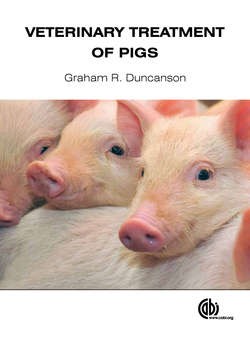Читать книгу Veterinary Treatment of Pigs - Graham R Duncanson - Страница 121
На сайте Литреса книга снята с продажи.
Оглавление4 Veterinary Equipment
Equipment for Handling
Naturally a bucket, brush, farmyard disinfectant, rubber boots and waterproofs are required.
You must not only be clean but also look clean. If there is a spray for cleaning your car wheels, use it. If there are foot dips on the farm, use them. If the farm provides clean boots and overalls, use them. If it provides plastic disposable over-boots, use them.
A strong rope, 5 m in length, is required for securing adult pigs to a fixed gate. Some 2 m × 2 m lengths of thin rope are required to help with restraint of an adult pig’s legs when it is in a crate. A pig snare is a vital requirement (Fig. 4.1).
Equipment for Diagnosis
Arm-length sleeves are required for internal examinations but are probably not used for actual parturition procedures. A digital camera is important so that the clinician has the ability to take pictures and download the photographs, label them, store them, and send them as attachments to e-mails. A stethoscope is required but it is not as useful as in other species. Various types of swab are required. Some should have transport media and some plain. A clinical thermometer is vital. The traditional glass thermometers will last for years if kept carefully in a plastic case. They are hard to acquire in the UK because of the mercury content. However, there are digital thermometers available. The clinician needs to choose whether the thermometer reads Centigrade or Fahrenheit. It is just a matter of which the clinician is happy with.
In pet pig practice often pigs are either seen in the hours of darkness or are contained in a dark hut. A head torch is useful on these occasions. It is also useful for dentistry (see below).
Equipment for Treatment
A variety of hypodermic needles of different sizes with luer fitting are required. A variety of disposable syringes of different sizes are needed with luer mounts. Practitioners also require a strong, non-disposable plastic syringe with a luer-lock needle fitting. A large, all-metal needle is required to avoid the risk of a broken needle. This is for injecting unrestrained pigs (Fig. 4.2).
There are automatic injection systems which allow up to 20 ml to be injected im from up to 1.5 m away. These are very effective. Some practitioners inject unrestrained pigs by the use of a piece of extension tubing connected between the needle and the syringe. The pig is jabbed and then the drug is injected by the practitioner following behind. The advantage is that if the pig breaks away, the needle can be pulled out and not left in situ. The author has had only variable success with this procedure as often the needle is dislodged too early.
Fig. 4.1. A pig snare.
Fig. 4.2. Non-disposable syringe for a rapid injection.
Spinal needles 15 cm in length with luer fitting are required for euthanasia. A 25 cm seaton needle with uterine tape is needed to place a ‘Buhner suture’ for vaginal and uterine prolapses. A 15 cm curved cutting edged suturing needle with braided nylon suture material is required for purse string sutures in pigs with rectal prolapses.
Equipment for the Feet
Hoof knife
The type of knife is a very individual choice. Obviously there are knives for left and right hands. Equally there are double-sided knives which can be used in either hand. The looped knives are useful for removing the softer parts of the hoof.
Hoof trimmers
The large size is required for adult pigs (Fig. 4.3).
Gutter tape
A roll of this tape is very useful for making bandages waterproof in the hoof area. The tape is also useful for covering poultices (Fig. 4.4).
Small sheep-size hoof clippers
These should be kept well oiled (Fig. 4.5).
Fig. 4.3. Large hoof trimmers.
Fig. 4.4. Waterproof tape for bandaging feet. Often called gutter tape.
Fig. 4.5. Small sheep-size hoof clippers.
Equipment for Dentistry
